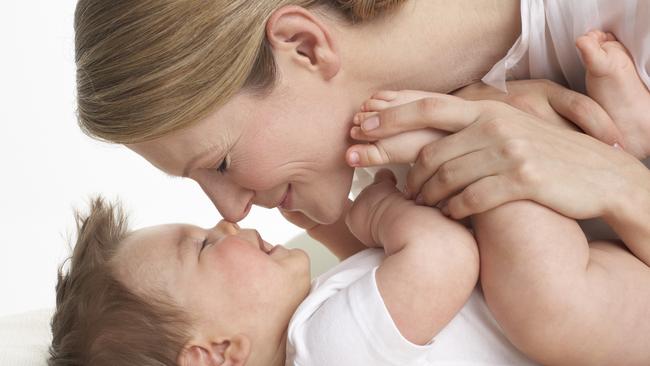
baby is flooded with feel-good hormones. Picture: Getty Images
We all exist somewhere along the empathy spectrum from slightly selfish to complete psychopath. Harmful belief systems about women embedded in our culture can be tempered by healthy empathy function or become unbridled by an empathy deficit.
Empathy isn’t some vague feel-good notion of kindness; it is a specific part of our brain architecture. Neuroscientists understand in detail its place in our emotional brain circuits, how we come to develop empathy and to what extent.

A review of neurobiological research published in The Journal of Neuropsychiatry and Clinical Neurosciences in 2016 traced the emergence of empathy deficits in detail from birth right up to violent adult offending, specifically intimate partner violence. The authors describe how empathy development starts at birth, when newborns will do whatever it takes to engage a caregiver. They mimic movements, search for faces, reach for skin and cry as a last resort. They have mirror neurons that enable them to tune into caregivers’ behaviours as early as 72 hours old.
A baby’s earliest attempts to engage another normally elicits a positive response from the caregiver that results in the baby being held or fed and flooded with relaxing, feel-good hormones. The baby repeats the process of engaging a carer, building increasingly complex and well-trodden empathic neural pathways. It is from this biochemistry and brain architecture that they develop pro-social behaviours, emotional regulation and an intuitive understanding of how to relate to another.
Where things go wrong is if an infant’s attempts to engage are not rewarded and empathic neural pathways become underdeveloped. If your parents or carers don’t love you or have difficulty showing it you will have a hard time developing empathic abilities.
The neurobiology review analysed almost 200 of the most significant sources establishing a link between empathy deficit or dysfunction and violence. The authors argued the empathy patterns in offenders explained why far fewer women, with neurobiology that predisposes them to increased empathy, were perpetrators of violence.

Research in empathy development surged in 2001 when Yale University researchers worked out how to scan healthy infants and toddlers in magnetic resonance imaging machines that required them to be still. Instead of using sedation, which blunted brain activity and posed ethical problems, researchers scanned babies in natural sleep and flung open the doors on a whole field of unexplored territory.
While researchers had been using neuroimaging for decades to unravel the mysteries of adult brains, it is only in recent years that infant brains have come under the microscope and only since the 2000s that we began studying longitudinal cohorts. Perhaps the most striking finding has been that the emotional brain circuitry of infants is far more advanced and sensitive than initially thought.
“We know that brain circuits for mood, depression, anxiety, addiction and resilience are all built between conception and age three and last for life,” Canadian neuroscientist Greer Kirshenbaum writes in her book The Nurture Revolution. “After three years of age the most frequently used brain circuits are covered in protective cells and the circuits that were not used frequently are eliminated by pruning.”
As neuroimaging was applied in the fields of neurobiology, genetics and behavioural science, the lasting effects of early life stress became undeniable. While our emotional brain is influenced by genetics and continues to develop into early adulthood, the foundations of emotional health are laid by our earliest experiences and relationships. We know in chronic states of prenatal and infancy stress the brain develops abnormally. In 2019, researchers from the Infant Brain Imaging Study Network demonstrated that the amygdala, the part of the brain that identifies threats and controls emotional processes, had started to overgrow at six months of age in children who later would be diagnosed with neurodevelopmental disorders. It has been shown that environmental stress combined with a genetic vulnerability to stress can increase the risk of developing autism.
While we have not yet discovered genes for any specific mental illness, in the 1990s researchers began uncovering the relationship between genes that determine our dopamine receptivity, how much of the feel-good hormone we can access, and children characterised as ultrasensitive or resilient.
University of California, San Francisco pediatrics and psychiatry professor Thomas Boyce brought into the mainstream the theory that about four-fifths of all children were born “dandelions” with genes that increased dopamine receptivity and made them more resilient to stress.
Boyce found the remaining children carried a gene morphism that rendered them less receptive to dopamine and categorised them as “orchids” for their ultrasensitivity to growing conditions. Orchids can flourish in ideal conditions or be affected by poor conditions.
High-quality care and reliable early relationships have been found to mitigate the orchid and dandelion effect. Kirshenbaum explains nurturing care as a crucial way of “turning the volume down” on genes less favourable to psychological resilience. Nonetheless, orchid children are more sensitive to stress in infancy and face a greater likelihood of their brain being hypersensitive to stress later in life.
Stress is at the seat of the development of all mental illnesses because it interferes with normal brain development and the naturally resilient emotional circuits that come with it. If stress is shaping the brain from infancy, the makings of a narcissist, schizophrenic, addict or psychopath are well under way in the cradle.
Unthinkable acts such as those we have witnessed in recent weeks are undeniably rooted in terrible brain architecture and resulting poor moral formation. Emotional deficits impede moral formation, which usually develops through an intuitive understanding of our actions in relation to others. Being able to share or imagine the feelings of another is a deterrent for treating them horribly. A brain imaging study in The Netherlands in 2013 found psychopathic criminals lacked automatic empathic processes. The line between right and wrong becomes blurred if we lack an intuitive sense of how another may feel or to share the feeling.
In this way, empathy is a crucial moderator of our behaviour in real time but also shapes our humanity. It is a kind of panacea to societal ills. External moderators of behaviour such as judicial and governance guardrails can get us only so far before internal motivation to do the right thing must take over.
Empathic dysfunction is the breeding ground for a raft of mental disorders because our ability to connect with others is our lifelong emotional mooring. Without empathy and the relationships that spring from it the world becomes disorienting and meaningless. Without a web of healthy connection around us, people who can act as a sounding board or offer different perspectives, we also become more vulnerable to radicalisation and conspiracy theories. We fill the void created by lack of interpersonal relations with consumerism, extreme interpretations of religion and political outrage.
Empathy deficits are clearly an enabler when it comes to men being able to dehumanise women and subjecting them to shocking violence. We cannot hope to reduce violence against women without interrogating the formative experiences of perpetrators. This is not an excuse for the behaviour, this is cut-and-dried science. We must go back to the beginning.
The good news is empathy deficits are preventable. If we are raised in nurturing and responsive environments where empathy is modelled to us we are likely to develop healthy levels of empathy. Known inhibitors of empathy development include reduced face-to-face human interaction, caregivers who lack empathy and toxic stress. We have to feel safe and connected most of the time to be able to adopt empathic behaviours.
The bad news is empathy is difficult to teach later in life and deficits are difficult to reverse. We can train our empathy “muscles” later in life, but it is far less effective than having it in the first place. It may never be automatic or intuitive. It is unclear whether former prime minister Scott Morrison’s empathy consultant employed in 2019 had any lasting influence.
The availability of empathy training courses has accelerated in response to a well-documented decline in empathy levels across the board. A study of American students published in the Personality and Social Psychology Review found levels of empathy fell by 48 per cent between 1979 and 2009. It seems unlikely a one-hour online minicourse in empathy will do much to counter the broader trend.
Short-term emergency responses to public outcries about violence is warranted, but we are also missing the point. Prevention is much more effective. Our outrage should be equally, if not more so, directed at the way we deny children the basic conditions for healthy emotional development: social interaction, proper food and the presence of invested, loving and consistent caregivers.
Parents are often time poor and stressed, which means they lack the emotional resources to respond to their children. They increasingly rely on screens to regulate themselves and their children. You don’t have to be a behavioural scientist to see this is a chronically stressful arrangement.
Adult mental illness and resulting behaviours become a complex question when we consider that as a baby that offender was exposed to conditions they had no control over. We don’t get to choose our parents or circumstances. Our individual responsibility is to come to understand our emotional circuitry and manage it, but we will continue to contend with limitations posed by the brain circuitry laid in our earliest years. Some will be more disadvantaged by this than others. Some will be rendered incapable of helping themselves.
Without a complete overhaul in our cultural and policy approach to the early years we cannot hope to address mental illness effectively. If more people understood the significance of support to ensure the healthy development of babies and children we could transform society as we know it. We underestimate the importance of this at our peril.






Rapists, murderers, religious extremists and even your garden variety nasty colleague have one thing in common: an empathy deficit. The part of their brain that imagines how others think and feel is anywhere from stunted to easily ignored. This allows them to dehumanise others to varying extents and prioritise their own gratification or agenda above all else, regardless of the pain this may cause those around them. They can be all charm one minute and conveniently deaf and blind to the suffering of another the next.